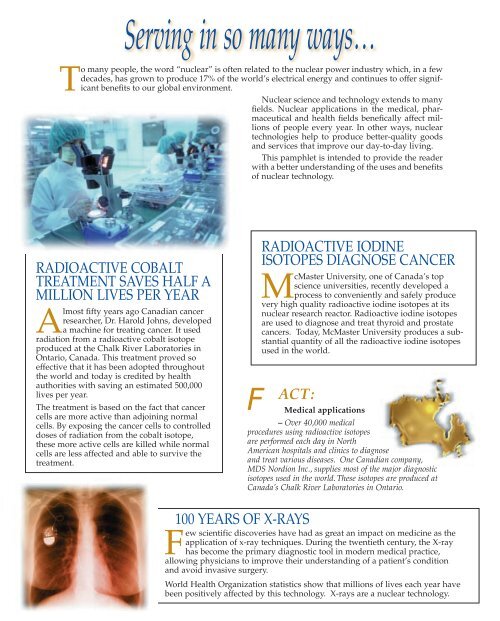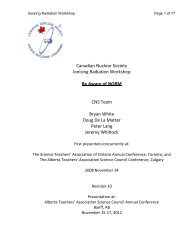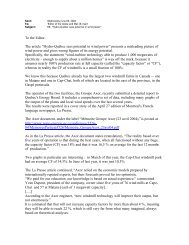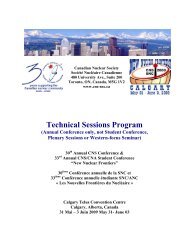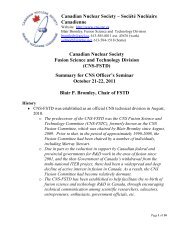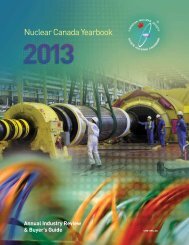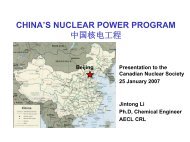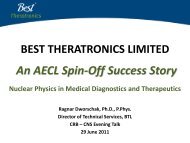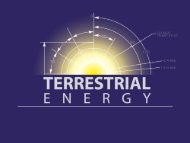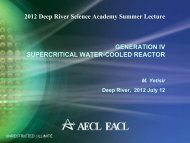Nuclear Advantage - Canada Edition - media.cns-snc.ca
Nuclear Advantage - Canada Edition - media.cns-snc.ca
Nuclear Advantage - Canada Edition - media.cns-snc.ca
Create successful ePaper yourself
Turn your PDF publications into a flip-book with our unique Google optimized e-Paper software.
RADIOACTIVE COBALT<br />
TREATMENT SAVES HALF A<br />
MILLION LIVES PER YEAR<br />
Almost fifty years ago Canadian <strong>ca</strong>ncer<br />
researcher, Dr. Harold Johns, developed<br />
a machine for treating <strong>ca</strong>ncer. It used<br />
radiation from a radioactive cobalt isotope<br />
produced at the Chalk River Laboratories in<br />
Ontario, <strong>Canada</strong>. This treatment proved so<br />
effective that it has been adopted throughout<br />
the world and today is credited by health<br />
authorities with saving an estimated 500,000<br />
lives per year.<br />
The treatment is based on the fact that <strong>ca</strong>ncer<br />
cells are more active than adjoining normal<br />
cells. By exposing the <strong>ca</strong>ncer cells to controlled<br />
doses of radiation from the cobalt isotope,<br />
these more active cells are killed while normal<br />
cells are less affected and able to survive the<br />
treatment.<br />
Serving in so many ways…<br />
To many people, the word “nuclear” is often related to the nuclear power industry which, in a few<br />
de<strong>ca</strong>des, has grown to produce 17% of the world’s electri<strong>ca</strong>l energy and continues to offer signifi<strong>ca</strong>nt<br />
benefits to our global environment.<br />
<strong>Nuclear</strong> science and technology extends to many<br />
fields. <strong>Nuclear</strong> appli<strong>ca</strong>tions in the medi<strong>ca</strong>l, pharmaceuti<strong>ca</strong>l<br />
and health fields benefi<strong>ca</strong>lly affect millions<br />
of people every year. In other ways, nuclear<br />
technologies help to produce better-quality goods<br />
and services that improve our day-to-day living.<br />
This pamphlet is intended to provide the reader<br />
with a better understanding of the uses and benefits<br />
of nuclear technology.<br />
RADIOACTIVE IODINE<br />
ISOTOPES DIAGNOSE CANCER<br />
McMaster University, one of <strong>Canada</strong>’s top<br />
science universities, recently developed a<br />
process to conveniently and safely produce<br />
very high quality radioactive iodine isotopes at its<br />
nuclear research reactor. Radioactive iodine isotopes<br />
are used to diagnose and treat thyroid and prostate<br />
<strong>ca</strong>ncers. Today, McMaster University produces a substantial<br />
quantity of all the radioactive iodine isotopes<br />
used in the world.<br />
F ACT:<br />
Medi<strong>ca</strong>l appli<strong>ca</strong>tions<br />
– Over 40,000 medi<strong>ca</strong>l<br />
procedures using radioactive isotopes<br />
are performed each day in North<br />
Ameri<strong>ca</strong>n hospitals and clinics to diagnose<br />
and treat various diseases. One Canadian company,<br />
MDS Nordion Inc., supplies most of the major diagnostic<br />
isotopes used in the world. These isotopes are produced at<br />
<strong>Canada</strong>’s Chalk River Laboratories in Ontario.<br />
100 YEARS OF X-RAYS<br />
Few scientific discoveries have had as great an impact on medicine as the<br />
appli<strong>ca</strong>tion of x-ray techniques. During the twentieth century, the X-ray<br />
has become the primary diagnostic tool in modern medi<strong>ca</strong>l practice,<br />
allowing physicians to improve their understanding of a patient’s condition<br />
and avoid invasive surgery.<br />
World Health Organization statistics show that millions of lives each year have<br />
been positively affected by this technology. X-rays are a nuclear technology.


